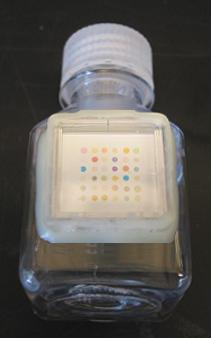Colour-changing dots detect blood-borne bacteria
10 September 2013
A team at the University of Illinois has developed a cheap disposable device containing a chemical sensing array (CSA) that can rapidly identify bacteria from the signature chemicals that they give off.
The new device consists of a plastic bottle, small enough to fit in the palm of a hand, filled with nutrient solution for bacteria to grow. Attached to the inside is an array of 36 pigment dots that change colour in response to chemicals released by bacteria. The device combines amplification of bacteria with detection and identification in a single sealed bottle.

The device, consisting of a bottle with
nutrient
solution and chemical sensing array
A blood sample from a patient is injected into the bottle, which goes onto a simple shaker device to agitate the nutrient solution and encourage bacterial growth. Any bacteria present in the blood sample will grow and release a signature odour that changes the colours of the pigment dots. The results can be read in a pattern of colour changes unique to each strain of bacteria. The device was tested with nine microorganisms, including two strains of E. coli and two strains of E. faecalis.
The new test produces results in 24 hours, compared to as much as 72 hours for current tests. It is also suitable for use in developing countries and other areas that lack expensive equipment in hospital labs.
“We have a solution to a major problem with the blood cultures that hospitals have used for more than 25 years to diagnose patients with blood-borne bacterial infections,” said Dr James Carey, who presented a report on the device at the 246th National Meeting & Exposition of the American Chemical Society (ACS). “The current technology involves incubating blood samples in containers for 24-48 hours just to see if bacteria are present. It takes another step and 24 hours or more to identify the kind of bacteria in order to select the right antibiotic to treat the patient. By then, the patient may be experiencing organ damage, or may be dead from sepsis.”
Sepsis, or blood poisoning, is a toxic response to blood-borne infections that kills more than 250,000 people each year in the United States alone. The domestic healthcare costs to treat sepsis exceed US 20 billion. In such a medical emergency, every minute counts, Carey explained, and giving patients the right antibiotics and other treatment can save lives.
Carey said the new device can identify eight of the most common
disease-causing bacteria with almost 99% accuracy under clinically
relevant conditions. Other microbes can cause sepsis, and the
scientists are working to expand the test’s capabilities. But Carey
said the device could make an impact now in reducing the toll of
sepsis, especially in developing countries or other medically
underserved areas.
“Our CSA blood culture bottle can be used
almost anywhere in the world for a very low cost and minimal
training,” Carey noted. “All you need is someone to draw a blood
sample, an ordinary shaker, incubator, a desktop scanner and a
computer.”